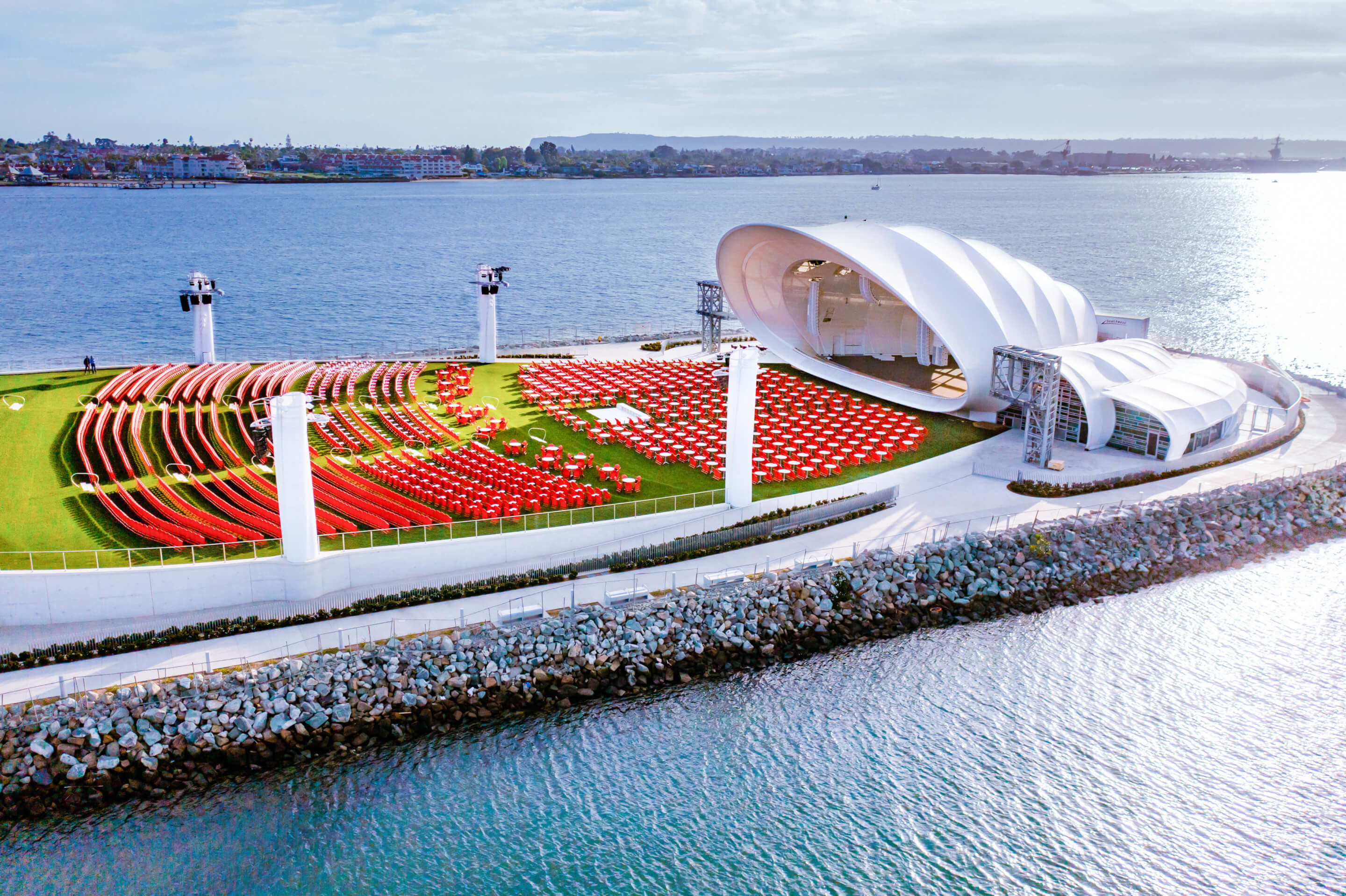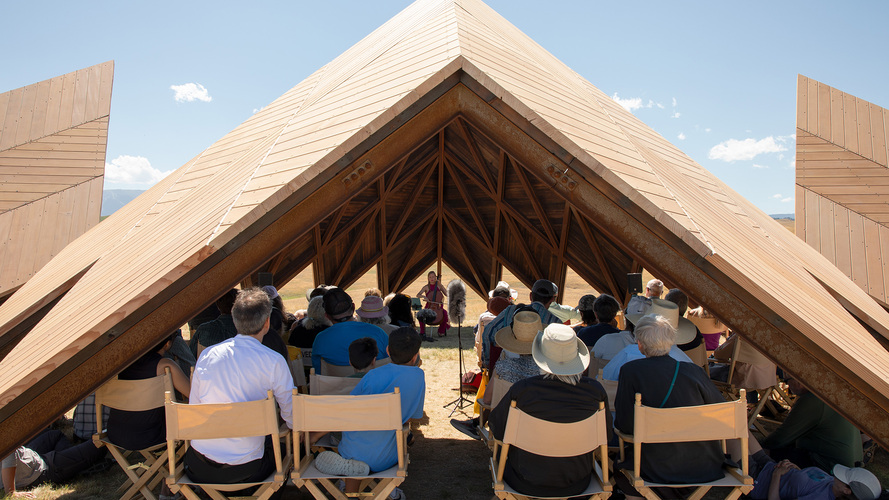When the weather warms up we go outside. Summer is the season for outdoor music-making, and it brings both a different aesthetic and, perhaps, slightly different expectations. Listening to music without being in a windowless concert hall has a very special magic: the compromises you may have to make acoustically (though often amazingly mitigated by the use of sophisticated amplification) are more than made up for by the experience of feeling connected to the natural world. Few things are more haunting than listening to a symphony orchestra under an open sky as the light fades; somehow the encroaching darkness makes one’s response to the music that bit more acute.
View author's page
Reading time estimated : 7 min
A couple of years ago I went to hear the San Diego Symphony and Rafael Payare in their outdoor home, the Jacobs Rady Shell, a striking venue on the waterfront of the South Californian city. The orchestra is housed in a large shell-like structure (not unlike the various “bowls” that have housed pops orchestras all over the States), but the audience sits outside. As Payare led the ensemble through Lorin Maazel’s Ring without Words confection (all the orchestral highlights from Wagner’s tetralogy strung together into a single tone-poem), some stunning abstract images were projected onto the “lip” of the shell providing a feast for the eyes, as the music nourished the ears.

And in the growing darkness, the lights of huge naval ships returning to the nearby base offered a strange counterpoint. Somehow, and I’m not sure why, the whole thing felt much more communal and connected than the traditional concert-hall experience. It certainly felt special, and touched by magic. And it definitely attracted a different audience to that which attends the San Diego orchestra’s regular indoor concerts.
A similar kind of magic happened last summer at Tippet Rise, an arts centre set in 12,500 acres of some of the most stunning scenery in Montana. The cellist Arlen Hlusko inaugurated The Geode, four arrow-shaped shells set in a hillside. The audience sat under three of them while she occupied the fourth, the shape of this Arup-designed performing structure, each shell lined with Douglas Fir treated using the Japanese yakisugi method of burning the wood and then brushing it. It projected the sound outwards as if amplified, get it was pure physics that connected musician and listener. She played a brand-new work by the Native-American composer Dawn Avery called Àkweks Katyes (“The Eagle Flies”) that referenced the tribes who’d once occupied this very land. Sitting outside, with the snow-capped mountains in the distance, the sun beating down but a gentle breeze keeping us cool, it was an amazing experience, and proved that man’s ingenuity could still be counted on to create extraordinary new ways of performing and listening to music.

Of course, the weather can play its own unwelcome role too. Back 1991, I went to hear Luciano Pavarotti in London’s Hyde Park. The audience was huge (about 150,000 people) and also very de luxe: Princess Diana, the Prime Minister John Major and his wife, the composer Andrew Lloyd Webber and the actor Michael Caine among them. Pavarotti back then gave his money’s worth and sang a substantial programme of operatic favourites, inevitably including Nessun dorma! from Puccini’s Turandot, an aria he’d made his own since the FIFA World Cup held in Italy the previous year when it featured in the BBC’s coverage’s opening credits. And it poured with rain! We were all soaked to the skin, including Princess Di who declined an umbrella so as not to block the view of people behind her. But it was an occasion to remember – for whatever reasons!
The setting for al fresco music can be hugely important, whether natural or manmade. Take Vienna’s Schönbrunn Palace, the summer residence of the Habsburg rulers since its construction in the 1740s and ‘50s. Every year since 2004, the Vienna Philharmonic gives a free concert for about 100,000 people in the grounds; the Palace itself, gorgeously illuminated, provides a magnificent backdrop. This year – on June 13 – Tugan Sokhiev takes to the podium for a sequence of classical pops, and the tenor Piotr Beczała sings some favourite operatic arias (even channelling his inner-Pavarotti for Nessun dorma!). Watch the 16 most recent Summer Night Concerts from Schönbrunn Palace on demand here.
Here in the UK we have a tradition of what’s often referred to as “country-house opera” where the experience of walking round the grounds or gardens and enjoying a picnic is almost as much part of the ritual as the music-making. Glyndebourne is the pinnacle: world-class opera with a great orchestra (the London Philharmonic or the Orchestra of the Age of Enlightenment), superb singers (often at the start of their careers) in a purpose-built theatre and invariably in productions directed by the greats of our day. Similar ventures have popped up in the past couple of decades, some with major orchestras too (the Philharmonia, for example, plays for Garsington Opera which stages its shows in a striking “semi-permanent” structure created in a beautiful natural setting). The long interval allows patrons, usually in evening dress, to enjoy a meal mid-performance. It’s a strangely British tradition and remains, thankfully, very popular.
The one downside of outdoor music-making is that it rarely – and not surprisingly – embraces the small-scale or solo. One extraordinary concert-hall, that fuses the exterior with the interior is Le Grange du Lac near Évian-les-Bains in the Haute-Savoie region of France. The concert hall was very much a gift to the great Russian cellist (and pianist and conductor) Mstislav Rostropovich from Antoine Riboud, the founder of the multinational food company Danone. Designed by the architect Patrick Bouchain, it is made of pine and red cedar wood and has a remarkably organic feel, almost like an extension of the woods that surround it, and here, music on a much more intimate scale can be performed to great effect. In this, Ravel Year (150 since his birth), the complete chamber music is being played by a group of musicians including Renaud Capuçon (violin), Guillaume Bellom and Arthur Hinnewinkel (piano), and the Quatuor Dutilleux. You may miss the smell of the wood, but even streamed you’ll get a sense of the hall’s magic as the artists take part in the Rencontres Musicales d’Évian.
Watch Ravel’s complete chamber music at the Rencontres Musicales d’Évian from June 29 here.
I set off for the Verbier Festival next month, and will be hosting some of the daily studios for the broascast in the Swiss town. The music-making may be indoors, but there’s definitely an outdoor element as there’s a very strong possibility that as you wander through the town you’ll see one of the major musical talents of today walking with friends, drinking a coffee or dashing off to a rehearsal. It’s a wonderful setting for some really fine music-making.

